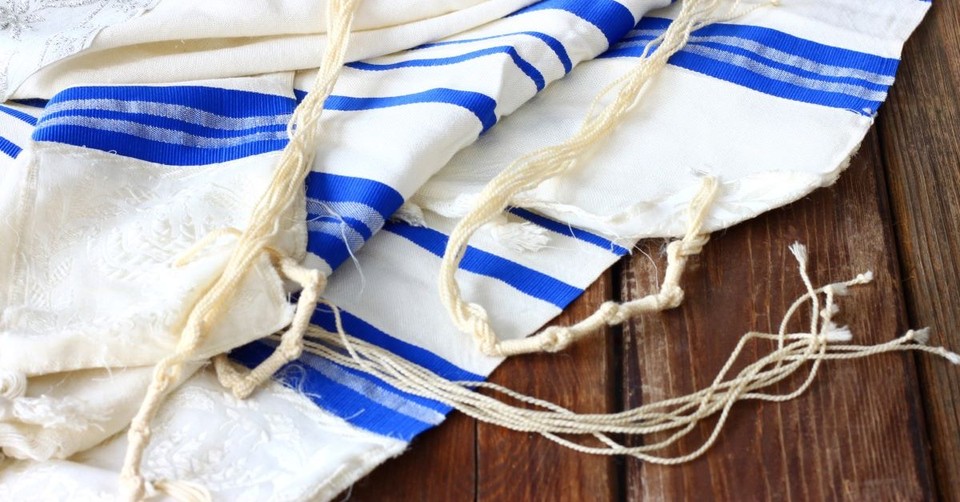What Is a Prayer Shawl and Why Is it Significant?

When I was a young woman attending my now husband’s church, I attended the ladies' fellowship meetings each month. One such meeting introduced me to the prayer shawl. There was a lady in our church that was having a rough time and the group wanted to gift her a prayer shawl.
This prayer shawl was to be crocheted in beautiful colors and prayed over before giving it to her. I had no idea what a prayer shawl was, and I certainly didn’t know what this lady was going to do with it. Years later, I still didn’t understand the purpose of a prayer shawl.
From my curiosity sprang a desire to know all about the sacred garment called a prayer shawl and what the significance of this garment was. What I found was a piece of cloth steeped in Jewish tradition with a beautiful purpose.
What Is a Prayer Shawl?
A prayer shawl, also called a tallit, is a special garment worn by Jewish men. The garment signifies the nobility that comes from being God’s chosen people. The tallit is a sign of obedience to God’s law.
Jewish women are not required to wear them, but some do during prayer time. Jewish children are often given the tallit at their bar mitzvah or bat mitzvah. Some Christians today use a prayer shawl during their prayer time.
Origin and History of Prayer Shawls
Prayer shawls go by many names, but the most accepted name is Tallit. Historically, prayer shawls or tallits were worn by Jewish men. After Moses led the Hebrew people from the land of Egypt and God spoke His commands, men began the practice of wearing a prayer shawl. These shawls were not only worn at times of prayer, but they were also worn throughout the day. Men would place them around their necks or under their outer garments.
It is believed the prayer shawl was designed similar to the outer garments Bedouins wore to protect their skin from the desert sun. That would explain the white shawl with black stripes. The shawls would have been made from a mixture of silk and wool. The Israelites would have used wool to show the connection to the sacrificial lamb.
The design included tassels placed at the four corners of the garment. Each tassel was to have eight threads and five knots on each corner of the garment. The total number of tassels equals 613, signifying the number of commandments God gave in the Torah.
Historically, only men were required to wear the tallit but today some women choose to wear them too. The color of the tallit is traditionally white with a blue thread running through the tassels. When the Jews were dispersed, blue thread was difficult to obtain, therefore it was accepted that other colors would be used.
Today, prayer shawls are designed and used much like they were historically. The Jewish people continue to use the prayer shawl to connect to God faster and more intimately.
Where Are Prayer Shawls Mentioned in the Bible?
Prayer shawls are not specifically mentioned in the Bible, but the garment is derived from Scripture references in the Torah. In Numbers 15:38-41, the Lord is speaking to Moses and says, “Throughout the generations to come you are to make tassels on the corners of your garment, with a blue cord on each tassel.” Deuteronomy 22:12 also says to make tassels on the four corners of the cloak you wear.
The purpose of the tassels was for the Israelite people to have a reminder of all God’s commands.
What Is the Significance of This Garment?
Throughout history, we find fringe garments, but the tallit is one of special significance. It gave God’s people a sense of power and authority.
Tassels, or fringe, were located at the hem of a garment. This was to signify the authority that the one wearing it had. For example, David cut a corner of Saul’s robe off and later felt guilty because of it. Saul was the king, and it was a great dishonor to cut his robe.
The colors for the shawl pointed to nobility. Blue, white, and purple are the colors used because of their significance. God mentions being clothed in purple in Ezekiel and Mordecai being clothed in royal apparel of blue and white, and a garment of purple in Esther. God is our King; therefore, His children are of noble lineage.
Wearing a prayer shawl during times of prayer is like having a tent meeting with the Lord.
How Is a Prayer Shawl Worn?
The prayer shawl is a sacred garment to the Jewish people. The shawl is worn not just on special occasions, but every day. It is often worn under the outer garment, but not touching the skin. The tassels hang from under the outer garment, in sight of others.
When the prayer shawl is put on each morning, a special blessing is said. The shawl would be placed in front of you as you say these words:
Blessed are you, Adonai our God,
Sovereign of all,
who hallows us with mitzvot,
commanding us to wrap ourselves in the fringes.
Once the blessing is said, then you would wrap the shawl around your shoulders. Some choose to place the shawl on their head for a moment before wrapping their shoulders.
For the Jewish people, wearing a prayer shawl is a sign of obedience to God’s commands. The shawl represents a sense of personal space. It can feel like you are wrapped in the arms of God.
Although the prayer shawl does not hold as much significance for Christians, it is still an item that is special to us. When we read Scripture or spend time in prayer and meditation, a prayer shawl can be comforting. It can help us feel closer to God. Our time spent with the Father can feel more personal.
Why Do Christians Not Wear These Today?
Jesus was a Jew and would have worn a cloak with fringe. There are stories in the Bible about the sick touching the hem of Jesus' cloak. Your cloak with tassels was a holy piece. It signified your beliefs and love for the one true God. Before Jesus came to Earth, the prayer shawl was a requirement for His people.
Once Jesus died on the cross for us, we no longer had that requirement. We were free from the law.
Often, Christians will purchase a prayer shawl while on a trip to the Holy Land or online markets. They are a reminder for us of what God did for His chosen people and what He did when He sent His son to die for us.
Christians don’t wear prayer shawls because of our belief that the Messiah has come, and we live under the new covenant. Today we find ladies groups crocheting shawls for other ladies. They are given as gifts during a time of grief or sickness.
A prayer shawl for Christians can have intricate designs and colorful themes. Even though we are not required to wear them, they are nonetheless special.
Prayer shawls have a rich history within the Jewish community. They are a beautiful and sacred garment always worn during daylight hours. Today, a prayer shawl is still precious and sacred for the Christian. It is usually given as a gift to a person who is facing difficult circumstances. They don’t look like the tallit Jesus wore, but they serve as a reminder that we are carried through this life wrapped in the arms of our Father.
Photo Credit: ©GettyImages/tomertu

This article is part of our Prayer resource meant to inspire and encourage your prayer life when you face uncertain times. Visit our most popular prayers if you are wondering how to pray or what to pray. Remember, the Holy Spirit intercedes for us, and God knows your heart even if you can't find the words to pray.
The Lord’s Prayer
Prayer for Peace
Morning Prayers
Good Night Prayers
Prayer for Healing
Prayer for Protection
Prayer for Anxiety
Prayer for Strength
Now available is our new Daily Prayer devotional and podcast! An easy way to start your day with prayer: read or listen to today’s prayer and sign up to receive it by email.
Originally published March 08, 2021.








